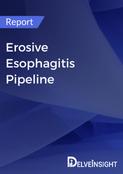erosive esophagitis pipeline insight
DelveInsight’s, “Erosive Esophagitis - Pipeline Insight, 2025,” report provides comprehensive insights about 3+ companies and 3+ pipeline drugs in Erosive Esophagitis pipeline landscape. It covers the pipeline drug profiles, including clinical and nonclinical stage products. It also covers the therapeutics assessment by product type, stage, route of administration, and molecule type. It further highlights the inactive pipeline products in this space.
Geography Covered
- Global coverage
Erosive Esophagitis Understanding
Erosive Esophagitis: Overview
Erosive Esophagitis (EE) is a major type of gastroesophageal reflux disease (GERD), characterized by erosions in the gastric mucosa caused by acidic reflux of stomach contents into the esophagus. The symptoms of EE include: difficult swallowing, painful swallowing, chest pain, swallowed food becoming stuck in the esophagus (food impaction), heartburn, and acid regurgitation. A diagnosis of EE is based upon a thorough clinical evaluation and physical examination. Tests like Barium X-ray and endoscopy are done. Laboratory tests are done to check for Infectious esophagitis. Treatment for Erosive Esophagitis is based on treating the underlying cause of disorder, use of therapies intended to lessen symptoms, and to manage complications. Medications involved over-the-counter treatments like antacids (Maalox, Mylanta etc.), H-2-receptor blockers, such as cimetidine and ranitidine, proton pump inhibitors, such as lansoprazole and omeprazole, and Potassium-competitive acid blockers are used.
"Erosive Esophagitis - Pipeline Insight, 2025" report by DelveInsight outlays comprehensive insights of present scenario and growth prospects across the indication. A detailed picture of the Erosive Esophagitis pipeline landscape is provided which includes the disease overview and Erosive Esophagitis treatment guidelines. The assessment part of the report embraces, in depth Erosive Esophagitis commercial assessment and clinical assessment of the pipeline products under development. In the report, detailed description of the drug is given which includes mechanism of action of the drug, clinical studies, NDA approvals (if any), and product development activities comprising the technology, Erosive Esophagitis collaborations, licensing, mergers and acquisition, funding, designations and other product related details.
Report Highlights
The companies and academics are working to assess challenges and seek opportunities that could influence Erosive Esophagitis R&D. The therapies under development are focused on novel approaches to treat/improve Erosive Esophagitis.
Erosive Esophagitis Emerging Drugs Chapters
This segment of the Erosive Esophagitis report encloses its detailed analysis of various drugs in different stages of clinical development, including phase III, II, I, preclinical and Discovery. It also helps to understand clinical trial details, expressive pharmacological action, agreements and collaborations, and the latest news and press releases.
Erosive Esophagitis Emerging Drugs
Fexuprazan: Neurogastrx
Fexuprazan is a potassium‐competitive acid pump antagonist, which reversibly blocks the proton pump that secretes gastric acids located in the cannalicular membrane. It is a next-generation of proton pump inhibitors (PPI) and is under Phase III clinical development in patients with Erosive Esophagitis.
YYD601: YooYoung Pharmaceutical
YYD601 (Esomeprazole magnesium dehydrate) is a leading proton pump inhibitor. The drug is being developed by YooYoung Pharmaceutical for the treatment of peptic ulcer and gastro-oesophageal reflux disease. The therapy is currently under Phase III clinical development for the treatment of Erosive Esophagitis.
Further product details are provided in the report……..
Erosive Esophagitis: Therapeutic Assessment
This segment of the report provides insights about the different Erosive Esophagitis drugs segregated based on following parameters that define the scope of the report, such as:
- Major Players in Erosive Esophagitis
There are approx. 3+ key companies which are developing the therapies for Erosive Esophagitis. The companies which have their Erosive Esophagitis drug candidates in the most advanced stage, i.e. Phase III include, Neurogastrx.
Phases
DelveInsight’s report covers around 3+ products under different phases of clinical development like
- Late stage products (Phase III)
- Mid-stage products (Phase II)
- Early-stage product (Phase I) along with the details of
- Pre-clinical and Discovery stage candidates
- Discontinued & Inactive candidates
- Route of Administration
Erosive Esophagitis pipeline report provides the therapeutic assessment of the pipeline drugs by the Route of Administration. Products have been categorized under various ROAs such as
- Oral
- Parenteral
- Intravitreal
- Subretinal
- Topical
- Molecule Type
Products have been categorized under various Molecule types such as
- Monoclonal Antibody
- Peptides
- Polymer
- Small molecule
- Gene therapy
- Product Type
Drugs have been categorized under various product types like Mono, Combination and Mono/Combination.
Erosive Esophagitis: Pipeline Development Activities
The report provides insights into different therapeutic candidates in phase III, II, I, preclinical and discovery stage. It also analyses Erosive Esophagitis therapeutic drugs key players involved in developing key drugs.
Pipeline Development Activities
The report covers the detailed information of collaborations, acquisition and merger, licensing along with a thorough therapeutic assessment of emerging Erosive Esophagitis drugs.
Erosive Esophagitis Report Insights
- Erosive Esophagitis Pipeline Analysis
- Therapeutic Assessment
- Unmet Needs
- Impact of Drugs
Erosive Esophagitis Report Assessment
- Pipeline Product Profiles
- Therapeutic Assessment
- Pipeline Assessment
- Inactive drugs assessment
- Unmet Needs
Key Questions
Current Treatment Scenario and Emerging Therapies:
- How many companies are developing Erosive Esophagitis drugs?
- How many Erosive Esophagitis drugs are developed by each company?
- How many emerging drugs are in mid-stage, and late-stage of development for the treatment of Erosive Esophagitis?
- What are the key collaborations (Industry-Industry, Industry-Academia), Mergers and acquisitions, licensing activities related to the Erosive Esophagitis therapeutics?
- What are the recent trends, drug types and novel technologies developed to overcome the limitation of existing therapies?
- What are the clinical studies going on for Erosive Esophagitis and their status?
- What are the key designations that have been granted to the emerging drugs?

